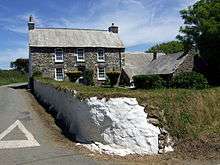Trefasser
Trefasser (variations: Tref-Asser, or Trêf Asser, or Asserton; translation: "town" of "Asser")[1][2][3] is a hamlet, located to the west of Fishguard and south of Pwll Deri in western Wales. Historically, it is part of the parish of Llanwnda. It lies on the coast of St George's Channel[2] within the Pembrokeshire Coast National Park. A stream named Cledde Goch runs close by.[4]
| Trefasser | |
|---|---|
 Trefasser Location within Pembrokeshire | |
| Principal area | |
| Country | Wales |
| Sovereign state | United Kingdom |
| Police | Dyfed-Powys |
| Fire | Mid and West Wales |
| Ambulance | Welsh |
Trefasser's farms, houses and cottages are the only settled area of Pen Caer.[5] David Tress has painted the place in an abstract painting.
History

Trefasser was mentioned in the survey of episcopal lands in 1326.[5] It at one time belonged to Major Thomas Askwith Jenkins (1809–1877) of Trevigin.[6]
In July 2009, the body of a 47-year-old man from Stourbridge in the West Midlands was found at the bottom of the cliffs of Trefasser.[7]
Etymology
There are opposing views as to from whom the name derives. One possibility is that it is the namesake of Bishop Asser, a friend and biographer of King Alfred in the 9th century. Another possibility is that it is named for Asser's nephew, Asser Meneventsis, as Trefasser is said to be his birthplace. Meneventsis was a Benedictine monk, as well as scribe and chancellor to Asser.[3][6][8][9]

Castell Poeth
A tumulus named Castell Poeth ("the Hot Castle") is located nearby. It is an exploratory castelet with an occasional beacon.[10] Described as a ditched, raised enclosure, oval in shape, and measuring 30 m (98 ft) by 60 m (200 ft) across, it has an attached second oval measuring 46 m (151 ft) by 54 m (177 ft).[11]
References
- Charnock, Richard Stephen (1859). Local etymology: a derivative dictionary of geographical names. Houlston and Wright. p. 276.
- Carlisle, Nicholas (1811). A topographical dictionary of ... Wales, a continuation of the topography of the United Kingdom of Great Britain and Ireland. p. 4D.
- Morgan, Thomas (1887). Handbook of the origin of place-names in Wales and Monmouthshire. H.W. Southey. p. 208.
- The Transactions. London: Honourable Society of Cymmrodorion. 1970. p. 113.
- "Pen Caer". cambria.org.uk. Retrieved 4 October 2010.
- Nicholas, Thomas (1872). Annals and antiquities of the counties and county families of Wales: containing a record of all ranks of the gentry ... with many ancient pedigrees and memorials of old and extinct families. Longmans, Green, Reader. p. 903.
- "Man found dead on Trefasser cliff named by HM Coroner for Pembrokeshire". Western Telegraph. 22 July 2009. Retrieved 3 October 2010.
- Gorton, John (1833). A topographical dictionary of Great Britain and Ireland: compiled from local information, and the most recent and official authorities: Volume 3 of A Topographical Dictionary of Great Britain and Ireland. Chapman and Hall. p. 626.
- Gronow, J. (1849). A review of England and Wales, in which the historical events of every town, village, and place are briefly expressed. London: Simpkin and Marshall. p. 321.
- Nicholson, George (1840). The Cambrian traveller's guide, and pocket companion. London: Longman, Orme, Brown, Green, & Longmans. p. 263.
- Wiles, J. (2004). "CASTELL POETH". Royal Commission on the Ancient and Historical Monuments of Wales. Retrieved 4 October 2010.